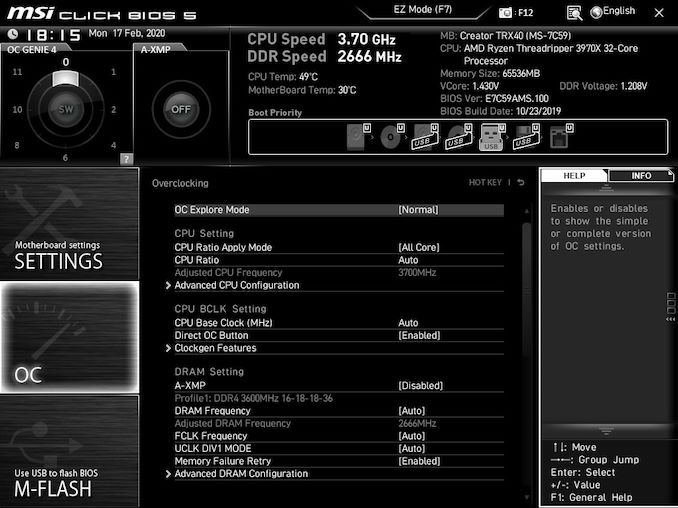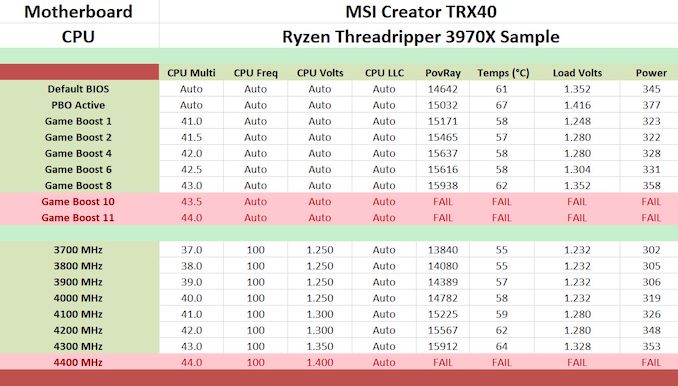The MSI Creator TRX40 Motherboard Review: The $700 Flagship for Threadripper
by Gavin Bonshor on February 26, 2020 11:30 AM EST- Posted in
- Motherboards
- AMD
- MSI
- Ryzen
- TRX40
- Threadripper 3000
- Creator TRX40
- 3970X
- sTRX4
Overclocking Ryzen 3000
Experience with the MSI Creator TRX40
One of the biggest requirements to overclocking Threadripper is the need for a capable and competent cooler. Due to the high core count of each of the three available models, they run very warmly as standard, and once all the cores are loaded up, keeping the beast under control can be a little difficult.
All of the settings for overclocking the processor and memory are within the OC section of the Advanced Mode. This includes CPU ratio and BLCK settings, as well as a multitude of voltage settings including CPU VCore, CPU SoC voltage, and more advanced power settings including LLC profiles. In the top left-hand corner is the OC Genie 4 selector which is identical to MSI's Game Boost overclocking profile switcher. OC Genie 4 is seven preset overclocking profiles for users to select from, with each profile stepping up in 50 MHz increments ranging from 4.1 to 4.4 GHz.
In addition to the processor settings, the Advanced DRAM Configuration menu can be found within the OC section. This is where all the memory latency settings are found including primary and sub timing latencies, as well as on-die termination settings. All the memory voltages can be set in the main area of the OC tweaker along with all the CPU related voltages.
Overclocking Methodology
Our standard overclocking methodology is as follows. We select the automatic overclock options and test for stability with POV-Ray and OCCT to simulate high-end workloads. These stability tests aim to catch any immediate causes for memory or CPU errors.
For manual overclocks, based on the information gathered from the previous testing, starts off at a nominal voltage and CPU multiplier, and the multiplier is increased until the stability tests are failed. The CPU voltage is increased gradually until the stability tests are passed, and the process repeated until the motherboard reduces the multiplier automatically (due to safety protocol) or the CPU temperature reaches a stupidly high level (105ºC+). Our testbed is not in a case, which should push overclocks higher with fresher (cooler) air.
Overclocking Results
In our overclocking testing with our AMD Ryzen Threadripper 3970X, we learned that our chip is capable of 4.3 GHz with our chosen cooling method. This is consistent throughout all the TRX40 boards we have tested so far, and is quite impressive as it equates to 32-cores running at 4.3 GHz. Starting from 3.7 GHz up to 4.3 GHz, we found that the MSI Creator TRX40 did experience some VDroop with some slight under volting at each of the frequencies we tested. As we went up in each 100 MHz, performance in POV-Ray also increased incrementally to complement this.
The MSI Creator TRX40 does include seven predefined overclocking presets which range from 4.1 to 4.4 GHz, each with its own set of parameters. Each profile except the highest two (GB10, GB11) all remained stable with sensible levels of CPU VCore voltage. Enabling AMD's Precision Boost Overdrive setting did yield some benefits to performance and is useful for novice users looking to squeeze more performance out at the extra cost of heat and power consumption. For better control over temps and to better exploit applications that use multiple cores and threads, manually overclocking is the way to go. That being said, MSI's included presets are actually useful and stack up well in terms of CPU Vcore used and power consumption when compared to each other.













42 Comments
View All Comments
babli2020 - Saturday, March 28, 2020 - link
amazing post.https://akcrack.com/typing-master-pro-10-crack/